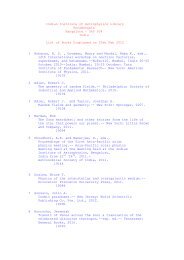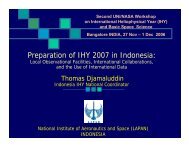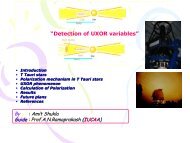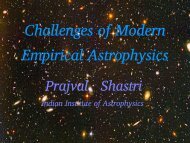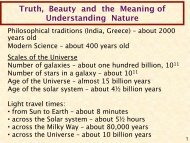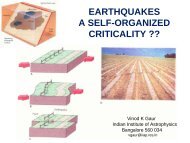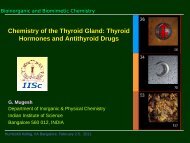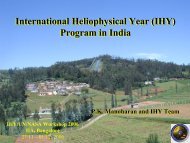ISM Structure - Indian Institute of Astrophysics
ISM Structure - Indian Institute of Astrophysics
ISM Structure - Indian Institute of Astrophysics
You also want an ePaper? Increase the reach of your titles
YUMPU automatically turns print PDFs into web optimized ePapers that Google loves.
Jayant Murthy<br />
<strong>Indian</strong> <strong>Institute</strong> <strong>of</strong> <strong>Astrophysics</strong><br />
jmurthy@yahoo.com<br />
murthy@iiap.res.in<br />
http://www.iiap.res.in<br />
<strong>ISM</strong> <strong>Structure</strong>
Milky Way <strong>ISM</strong> Overview<br />
<strong>ISM</strong> confined to thin<br />
gaseous disk.<br />
Thickness ~500 pc.<br />
Sun at 8.5 kpc from<br />
center.<br />
Milky Way from Cobe<br />
http://messier.seds.org/more/mw_cobe.html
Milky Way <strong>ISM</strong> Overview<br />
Mass <strong>of</strong> MW within 15<br />
kpc <strong>of</strong> center:<br />
total: 10 11 M ⊙<br />
.<br />
stars: 5 x 10 10 M ⊙<br />
.<br />
dark matter: 5 x 10 10<br />
M ⊙<br />
.<br />
<strong>ISM</strong>: 7 x 10 9 M ⊙<br />
.<br />
Milky Way from Cobe<br />
http://messier.seds.org/more/mw_cobe.html
Phases <strong>of</strong> the <strong>ISM</strong><br />
Coronal gas (HIM)<br />
Filling factor > 0.5.<br />
Density ~ 0.001 cm -3 .<br />
T > 10 5.5 K.<br />
Heating from supernova<br />
explosions.<br />
Collisionally ionized.<br />
NGC 4631<br />
http://imagine.gsfc.nasa.gov/docs/features/news/01aug01.html
Phases <strong>of</strong> the <strong>ISM</strong><br />
Coronal gas (HIM)<br />
Cooling by:<br />
Adiabatic expansion.<br />
X-ray emission.<br />
Observations:<br />
Line emission in X-<br />
rays and O VI.<br />
Continuum<br />
synchrotron emission<br />
in radio.<br />
Chandra observations <strong>of</strong> NGC 4631<br />
http://imagine.gsfc.nasa.gov/docs/features/news/01aug01.html
Ionized Gas<br />
Ionized H II regions.<br />
f ~ 0.1.<br />
n H<br />
= 0.02 cm -3 .<br />
T ~ 10,000 K.<br />
Either diffuse <strong>ISM</strong><br />
(WIM) or bright H II<br />
regions.<br />
Photoionized; heating<br />
from electrons.<br />
http://monicks.net/2010/06/29/astronomy-picture-<strong>of</strong>-the-day-the-dark-tower-in-scorpius/
Ionized Gas<br />
Cooling by:<br />
Line emission<br />
including fine<br />
structure.<br />
Free-free emission.<br />
Observed:<br />
Optical line emission<br />
(Balmer emission).<br />
Thermal radio<br />
continuum.
Warm Neutral Gas<br />
Neutral hydrogen<br />
f = 0.1<br />
n H<br />
= 0.2 cm -3<br />
T = 5000 K<br />
Heating from electrons;<br />
starlight.<br />
http://www.centauri-dreams.org/?p=681
Warm Neutral Gas<br />
Cooling by line<br />
emission.<br />
Observed through:<br />
21 cm<br />
emission/absorption.<br />
UV/optical<br />
absorption lines.<br />
http://www.centauri-dreams.org/?p=681
Cold Gas<br />
Cold neutral medium<br />
T = 100 K<br />
nH = 30 cm -3<br />
f = 0.01<br />
Heating by photoelectrons<br />
from dust.<br />
Cooling by line<br />
emission.<br />
Observed through 21 cm<br />
and UV/optical lines.
Cold Gas<br />
Diffuse H 2<br />
:<br />
f = 0.001<br />
n H<br />
= 100 cm -3<br />
T = 100 K<br />
Protected against<br />
disassociation by H I.<br />
Cooling from fine<br />
structure lines.<br />
Observed through<br />
absorption lines/ CO<br />
emission.
Cold Gas<br />
Dense molecular clouds<br />
n H<br />
> 10 3 cm -3<br />
T = 10 K<br />
f = 0.0001<br />
Heating from<br />
electrons/cosmic rays.<br />
Self-gravitating.<br />
Star formation.<br />
Observed from CO<br />
lines.<br />
IR dust emission.
http://en.wikipedia.org/wiki/Interstellar_medium<br />
Summary
Abundances<br />
Start with Big Bang.<br />
Evolve through stellar<br />
nucleosynthesis.<br />
Back to stars.
Mass Cycle
Energy Flow
Interstellar Radiation<br />
Galactic synchrotron<br />
emission<br />
From (relativistic)<br />
accelerated charged<br />
particles.<br />
Relativistic electrons in<br />
the Galactic magnetic<br />
field.<br />
Enhancements near<br />
SNR.
Synchrotron Radiation
Interstellar Radiation<br />
Galactic synchrotron<br />
emission<br />
d m vv<br />
= = q q dt dt c c v xv Bx<br />
B<br />
Lorentz force:<br />
F = e[E + (1/c)(v x B)<br />
Equations <strong>of</strong> motion:<br />
d(γmv)/dt = (q/c) v x B.<br />
F is perpendicular to B<br />
so |v| is a constant.<br />
Helical motion.<br />
ω = qB/γmc
Interstellar Radiation<br />
Galactic synchrotron<br />
emission<br />
Lorentz force:<br />
F = e[E + (1/c)(v x B)<br />
d(γmv)/dt = (q/c) v x B.<br />
d m vv<br />
= = q q dt dt c c v xv Bx<br />
B<br />
P = 4/3 σ T<br />
cβ 2 γ 2 U B<br />
σ T<br />
= 8πr 02<br />
/3<br />
U B<br />
= B 2 /8π<br />
β is the speed
Interstellar Radiation<br />
Galactic synchrotron<br />
emission<br />
d (γm vv)<br />
= = q q dt dt c c v vx Bx<br />
B<br />
Radiation beamed about<br />
velocity vector.<br />
P(ν) ∝ ν -s<br />
s = (p – 1)/2<br />
particle energy: p<br />
Observations:<br />
0.4 – 23 GHz<br />
νu ν<br />
= 3∙10 -19 ν 0.1 erg<br />
cm -3<br />
Radiation polarized.
Interstellar Radiation<br />
Galactic synchrotron<br />
emission<br />
Cosmic microwave<br />
background<br />
d (γm vv)<br />
= = q q dt dt c c v vx Bx<br />
B<br />
Blackbody radiation.<br />
T = 2.755 K<br />
Isotropic, homgenous.<br />
Some peculiar motion<br />
due to Sun, Virgo etc.
CMBR
Interstellar Radiation<br />
Galactic synchrotron<br />
emission<br />
Cosmic microwave<br />
background<br />
Free-free emission.<br />
d (γm vv)<br />
= = q q dt dt c c v vx Bx<br />
B<br />
Bremsstahlung.<br />
Electron is inelastically<br />
scattered with emission<br />
<strong>of</strong> a photon.<br />
Continuum emission.
Interstellar Radiation<br />
Galactic synchrotron<br />
emission<br />
Cosmic microwave<br />
background<br />
Free-free emission.<br />
d (γm vv)<br />
= = q q dt dt c c v vx Bx<br />
B<br />
Bremsstahlung.<br />
Electron is inelastically<br />
scattered with emission<br />
<strong>of</strong> a photon.<br />
Continuum emission.<br />
where j is the free-free<br />
emissivity (power per<br />
unit frequency per unit<br />
volume per steradian)
Interstellar Radiation<br />
Galactic synchrotron<br />
emission<br />
Cosmic microwave<br />
background<br />
Free-free emission.<br />
d (γm vv)<br />
= = q q dt dt c c v vx Bx<br />
B<br />
Radiated power ∝<br />
n i<br />
n e<br />
T ½
Interstellar Radiation<br />
Galactic synchrotron<br />
emission<br />
Cosmic microwave<br />
background<br />
Free-free emission.<br />
Absorption.<br />
Using Kirch<strong>of</strong>f's Law.<br />
if hν
Interstellar Radiation<br />
Galactic synchrotron<br />
emission<br />
Cosmic microwave<br />
background<br />
Free-free emission.<br />
Recombination radiation<br />
Proportional to n e<br />
n i<br />
.<br />
Radio lines are Rydberg<br />
lines.<br />
Two photon emission.
Interstellar Radiation<br />
Galactic synchrotron<br />
emission<br />
Cosmic microwave<br />
background<br />
Free-free emission.<br />
Recombination radiation<br />
Starlight<br />
Integrated light <strong>of</strong> all<br />
stars.<br />
UV sky dominated by B<br />
stars.<br />
Visible sky by cool<br />
stars.<br />
Normally people use<br />
MMP model.
Interstellar Radiation<br />
Galactic synchrotron<br />
emission.<br />
Cosmic microwave<br />
background.<br />
Free-free emission.<br />
Recombination radiation<br />
Starlight.<br />
Dust emission.<br />
Scattered light from<br />
interstellar dust.<br />
Thermal emission from<br />
dust.<br />
Stochastic emission<br />
from small grains.
Summary



